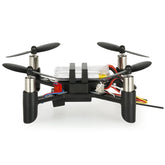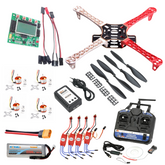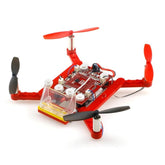DRONE FLYING UPDATED POLICY - INDIA
#BreakingNews: Drone Flying Finally Made Legal In India
All You Need To Know About the New Drone Policy - 2018
What is a Drone?
An Unmanned Aerial Vehicle (UAV) is a type of aircraft that operates without a human pilot onboard and is more commonly known as a drone. Remote control airplanes and helicopters can also be classified as UAVs when they have particular kinds of performance and remote control capabilities. Today, drones are used in several applications such as Security and Surveillance, and to deliver packages
Drones In India
Drones have become quite popular in the Nation and recently made their way into the Indian Market and Economy. But due to the presence of missing policies and incomplete regulations, users were prevented from using this technology to its full potential.
With the release of a new policy, Drone Enthusiasts have another chance at trying their hands at this Technology. The new policy shall be made applicable from 1st December 2018.
The Old Policy
- There are 5 types of drones: Nano, Micro, Mini, Small, and Large. These range from less than 250grams in weight to over 150 kg.
- Drones under 250g (Nano) won't need a security clearance.
- Micro category (250 g to 2 kg) will get approvals in 2 days.
- Whenever you operate a drone, you will need different approval. Apart from nano drones, all other categories will need an air defense clearance so that Aviation, as well as security authorities, are aware of the flight path.
- There will be no-drone zones such as the above operational aerodromes and within 5 km of Vijay Chowk in Delhi, within 500 meters from strategic locations, from mobile platforms such as a car, ship, or aircraft, over eco-sensitive zones like national parks and wildlife sanctuaries (unless approved by Environment Ministry).
- Drones less than 2 kg and operating under 200 feet in height, once registered, can be flown without nods.
- Drones can be used for photography, medical uses, ad film making, and so on.
- Air rickshaws or passenger drones can also be considered under this policy
New Policy
Do’s
- Registration: Drones have been categorized into five different categories based on weight – starting at less than 250 gm and the largest ones weighing more than 150 kg – and their end use. Barring the smallest (nano category of drones), all other categories of drones — micro, small, medium and large — need to be registered.
- Manufacturing drones: The new policy has defined different categories based on maximum takeoff weight which means manufacturers will have to keep in mind the needs of the consumers and policy restrictions while manufacturing drones. For example, if a drone is going towards an unauthorized area, it should have a functionality to come back to its base area.
- Flying small drones: A model aircraft of 2 kg without any payload, if flown below 200 ft inside closed premises, then no permission is required.
- Educational Institutions: Institutes don't have to apply for a unique identification number or UIN. Aeromodellers and recreational flyers under this category will be fully responsible for the operation, safety, and security of a drone. However, they will have to inform the local police before undertaking such activities even for indoor operation.
Don’t’s
- Operating an autonomous aircraft without any permission or UIN is now prohibited
- Flying without prior approval over densely populated or areas that affect public safety is prohibited
- Flying within 50 km of the international border
- Flying beyond 500 Meters into the Sea
- Flying near strategic locations
- You cannot fly a drone from a mobile platform such as a moving vehicle, ship, or aircraft
Source:
Which company makes drones in india?
India has become a rapidly growing hub for drone technology and is home to many companies that manufacture these sophisticated devices. One of the leading names in this sector is Tech-Edge Innovations Pvt Ltd, located in Bangalore.
For over 10 years, they have been manufacturing state-of-the-art drones with streamlined designs and various innovative features designed for professional use such as photography, surveillance missions or extended research projects requiring reliable aerial data acquisition. Their experienced engineers specialize in creating custom solutions that are tailored to each customer’s requirements which makes their services highly sought after by customers across India and overseas countries like the UK & US
They also offer comprehensive maintenance packages on all their products combined with unparalleled post-purchase support from dedicated customer representatives always available via phone or email 24 hours a day,7 days a week. This ensures complete peace of mind when using any product purchased through them knowing every issue can be fixed quickly no matter how serious it might be. All together making them one of the top choice providers within the Indian market today!
read more : What are drones? A-Z Guide Of Assembly to Flying
Why dji drones not available in india?
DJI faces unique challenges in launching its drones in India.
India is a particularly challenging market for the aviation industry due to its complex regulatory environment. Drone manufacturers like DJI are faced with a number of barriers, including:
Registration requirements: DJI's drones require registration in India if they have an airspeed above 15 kilometres per hour. This goes against Indian government regulations that prohibit any type of unmanned aircraft from flying at higher speeds than this.
BIS certification and Aircraft Act 1934 permissions: DJI's models falling within this speed limit range (Mavic series) would need to be BIS certified and obtain permissions required under the Aircraft Act 1934 before being legally used in India. DJI has decided not to pursue either step, leading many to question whether there was some political pressure involved.
Usage restrictions: The Ministry of Civil Aviation and DGCA Guidelines impose severe restrictions on the use of drones in India. These guidelines restrict flights over populated areas like national parks or military bases, making operations difficult and costly for potential users.
Discussions are underway between the Drone Major's Association (DRMA) and the Directorates regarding possible relaxations of these regulations, but no final decisions have been taken. Until then, it is very difficult to gain approvals to operate UAVs commercially in India.
read more : Drone Part List
Which country has banned the import of drones?
The Government of India has recently imposed a ban on the importation of drones into its country. This decision was made in order to reduce national security risks and ensure that these unmanned aircraft are only used for recreational or legal purposes. The move is meant to protect citizens from potential harm caused by malicious actors who could use unauthorized radio-controlled devices with objectionable intentions. Additionally, it will help control the entry point of items which have not been tested and approved by Indian aviation regulatory bodies before being imported into Indian airspace. As such, those wanting to bring their drone machinery must now look elsewhere outside India for this purpose due to recent changes in regulations prohibiting imports.
Which drones are allowed in india?
Drones are becoming increasingly popular in India, and more people are choosing to use them for recreational or commercial purposes. While the Indian government has put some regulations in place regarding drone usage, drones can still be operated with permits from the Directorate General of Civil Aviation (DGCA).
In order to fly a drone legally in India one needs permission from both local police authorities as well as an Unmanned Aircraft Operator Permit (UAOP) which is obtained through DGCA. Depending on where you intend to fly your drone there may also be additional state-specific permissions required- this should always be verified before flying. Additionally, it’s important that operators adhere strictly to all applicable safety guidelines during their flights such as only operating within visual line of sight and not exceeding maximum allowable altitude restrictions etc., so make sure these have been read carefully prior to any planned flight operations.
Drones used recreationally must weigh less than 2kgs whereas those intended for commercial applications need approval by DGCA if they exceed 25Kgs - Specialized agencies who provide services like aerial photography, surveying/ mapping & remote sensing operate under different regulations depending on what application is being sought after. Lastly, even though most states allow nighttime flight; Maharashtra does not permit night ops at present but may consider allowing these once sufficient infrastructure has been established. Taking into account all relevant rules & safety considerations when using drones will help ensure safe operation while avoiding violations & legal implications thereby helping create an enjoyable experience overall!
read more : Drone Motor – Where to Begin?
Which category of drones does not require registration for use?
Ready-to-fly drones do not require registration for use. These types of drones are designed to be user-friendly and come completely assembled with minimal setup required before takeoff. The prebuilt models include all the necessary components, such as batteries, motors, frames, propellers and controllers which make them ready to fly right out of the box without any additional assembly or customization needed. Additionally, these models have built-in safety features that further reduce a user's worry about crashing when using it outdoors - making this an ideal choice for hobbyists who may want to experience flying a drone but aren't yet comfortable dealing with all the parts involved in assembling one from scratch themselves.
Why drones are banned in india?
Drones are banned in India due to safety and security concerns.
Drones are considered unauthorized flying objects that can compromise the country's airspace without a license or permit from Indian authorities. Drone usage is restricted in certain urban areas by government regulation as they may risk public safety and could cause disruption of aviation activities if not flown with caution. Additionally, drone use has been associated with privacy concerns which cannot be ignored for national security reasons. Drone operators must obtain a valid authorization certificate before operating them within India's boundaries.
read more : Upgrade Your Control: Best Drone Remote Controllers
What height can camera drones fly in india?
Drones are immensely popular in India for recreational and professional purposes. In terms of altitude, there is no hard-and-fast rule about how high-camera drones can fly. However, several guidelines need to be taken into consideration before flying a drone at any height above ground level (AGL). Generally speaking, it is recommended that operating limits should not exceed 150 metres AGL as this might interfere with air traffic over urban areas or cause disruption in sanctuaries/protected zones such as wildlife reserves. Additionally, avoid supersonic speeds when using drones within a 5 km radius of airports due to safety regulations around protected airspace controlled by the Airports Authority of India (AAI). To ensure absolute safety while filming aerial footage you must always plan your flight path according to AAI requirements prior to operation.
Conclusion:
The recent policy updates surrounding drone flying in India mark a significant milestone for enthusiasts and professionals alike. With clearer guidelines, the drone community can now thrive responsibly. Understanding the categories of drones that don't require registration, the reasons behind the previous bans, and where to purchase drones, especially in cities like Bangalore, is vital. As we embrace this exciting change, it's essential to fly drones safely, respecting privacy and airspace regulations. The sky's the limit, and with this new policy, India's drone industry is set to take off like never before. Stay informed, fly responsibly, and let your imagination soar!
If you appreciate our work don't forget to share this post and leave your opinion in the comment box.
Please do check out other blog posts about Popular electronics
Make sure you check out our wide range of products and collections (we offer some exciting deals!)










